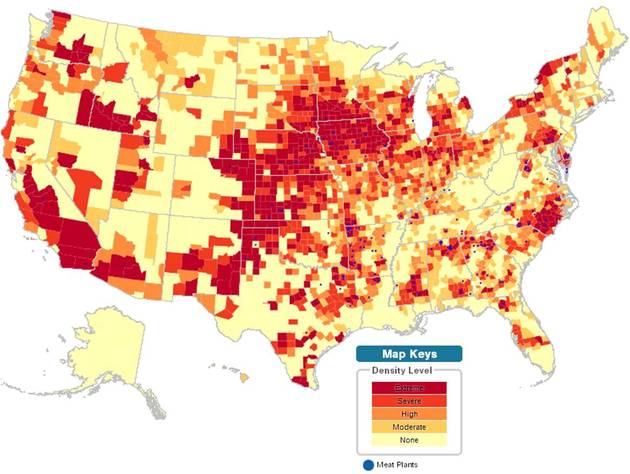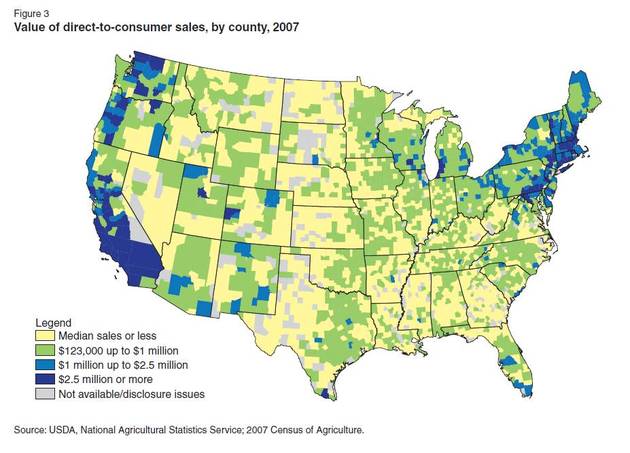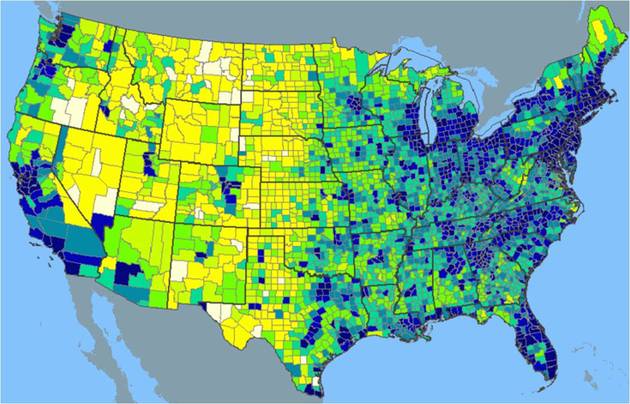In the recently released USDA study Direct and Intermediated Marketing of Local Foods in the United States there's a section dedicated to local food sales by region. Perhaps not surprisingly, the majority of local and direct-marketed food sales take place on the West coast and in the Northeast region (see map below). In this post I'll try to identify why this situation exists and some ideas for how it can be remedied.
Why is Local Food Concentrated on the Coasts?
Some might say that "urbanization", or areas with highly concentrated populations, are more conducive to local food sales and that population concentration on the West coast and in the Northeast could be skewing the results. However, the USDA report controls for urbanization and still finds a significant disparity. Not to mention the fact that other areas of the country are also highly populated. For instance, the South is highly concentrated from a population standpoint, yet it has an abysmal representation for local and direct-marketed food sales. Areas of the midwest also show highly concentrated populations. I don't think population density is the answer.
Here's a map. The darker shades represent higher population density:
If It's Not a Function of Population Density, What is it a Function of?
The USDA report highlights what it calls the "neighborhood effect", which postulates that areas with farms selling locally will influence other farms to sell local too. Sounds great, I guess, but what caused the initial farms to sell local in the first place? Also, just because one farm has success selling locally doesn't mean that other farms can jump on the bandwagon. There has to be the customer demand. Needless to say, I don't buy the "neighborhood effect" argument either.
Another argument by the USDA is that local food sales depend on the region and that sales will be higher when there is a higher concentration of fruit and vegetable producers in a region. This argument carries a little more clout in my mind, but still doesn't fully explain it. There's plenty of fruit and veggie farms across the country and there would probably be more if the demand existed. Again, this argument tries to explain why the producers exist without first considering why the customers (i.e. the demand) exist. We need to address the demand for local and understand the undelrying reasons why local-market farms find success.
Is the Distribution of Factory Farms a Factor?
Maybe the presence of large factory farms prevent local food sales from flourishing? The thought process goes like this: 1.) factory farms operate in a local area, 2.) factory farms provide jobs and generate income for the locality, 3.) lobbyists for factory farms buddy-up with local politicians, 4.) politicians make it difficult for small, local-market farms to compete.
Given their size and production processes, factory farms have greater local economies of scale and lower prices. In addition, factory farms often control, consolidate and dictate terms at slaughterhouses. Clearly, a large presence of factory farms could present quite a hurdle to local food producers.
According to the recently released Factory Farm Map, that might be a good argument for the Midwest region, but it still doesn't address the lack of local food sales in the South.
 Courtesy of www.factoryfarmmap.org
Courtesy of www.factoryfarmmap.org
My Belief: Awareness and Communication Spur Local Food Sales
My personal belief after having lived on the West coast, in the South and now in the Northeast is that the difference is awareness and communication. Local and direct selling exists in the South, but there isn't nearly the funding and coordination behind marketing local food and its benefits. In places like California and NYC there is a constant onslaught of marketing and education about food, where it comes from and why consumers should care. While there are some great organizations and very talented people promoting local food in the South it just isn't at the same scale. I think this has a big effect.
Consumer awareness is a huge factor in my opinion. Once people (Moms especially) start to understand where their food comes from and how it impacts their family's health there's a huge revelation. Before something that was a cost and a nuisance now becomes among the most important things in life, as it should be. Food is what sustains us. It keeps us healthy and alive. Local, organic and sustainably raised food better serves those goals than does factory farmed and industrially processed food. People just need to know why. Maybe our small farm can help a few families come to that realization down South. I'd like to see the USDA local foods map in 20 years. I hope our county is dark blue.




Back to News